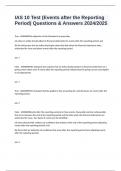Exam (elaborations)
IAS 10 Test (Events after the Reporting Period) Questions & Answers 2024/2025
- Course
- Institution
IAS 10 Test (Events after the Reporting Period) Questions & Answers 2024/2025 True - ANSWERSThe objective of this Standard is to prescribe: (a) when an entity should adjust its financial statements for events after the reporting period; and (b) the disclosures that an entity should give abou...
[Show more]



